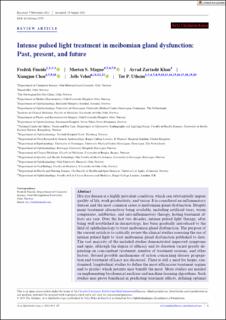Intense pulsed light treatment in meibomian gland dysfunction: Past, present, and future
Fineide, Fredrik; Magnø, Morten Schjerven; Khan, Ayyad Ahmad Zartasht; Chen, Xiangjun; Vehof, Jelle; Utheim, Tor Paaske
Journal article, Peer reviewed
Published version

Åpne
Permanent lenke
https://hdl.handle.net/11250/3092409Utgivelsesdato
2023Metadata
Vis full innførselSamlinger
- Department of Clinical Medicine [2066]
- Registrations from Cristin [9791]
Sammendrag
Dry eye disease is a highly prevalent condition, which can substantially impair quality of life, work productivity, and vision. It is considered an inflammatory disease and the most common cause is meibomian gland dysfunction. Despite many treatment alternatives being available, including artificial tears, warm compresses, antibiotics, and anti-inflammatory therapy, lasting treatment effects are rare. Over the last two decades, intense pulsed light therapy, after being well established in dermatology, has been gradually introduced to the field of ophthalmology to treat meibomian gland dysfunction. The purpose of the current article is to critically review the clinical studies assessing the use of intense pulsed light to treat meibomian gland dysfunction published to date. The vast majority of the included studies demonstrated improved symptoms and signs, although the degree of efficacy and its duration varied greatly depending on concomitant treatment, number of treatment sessions, and other factors. Several possible mechanisms of action concerning disease propagation and treatment efficacy are discussed. There is still a need for larger, randomised, longitudinal studies to define the most efficacious treatment regime and to predict which patients may benefit the most. More studies are needed on implementing biochemical analyses and machine learning algorithms. Such studies may prove beneficial in predicting treatment effects, defining optimal treatment regimens, and furthering our understanding of the mechanisms of action.
